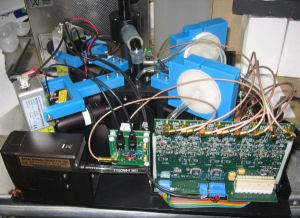WIBS3: Wide Issue Bioaerosol Sensor, version 3
The WIBS3 is an optical particle counter featuring a dual wavelength fluorescence spectrometer. It was constructed by CAIR at the University of Hertfordshire as part of the development of a fast, cheap, low-maintenance detector for airborne pathogens that might be intentionally released. Any discernibly biological particles suspended in the air are termed “primary biological aerosol particles” (PBAP). This category includes pollen, spores from fungi and plants, plant and animal debris, bacteria and viruses.
Biological fluorescence
Some molecules absorb radiation at one wavelength and, through changes in the energy state of an electron, rapidly re-emit at a longer wavelength in a phenomenon known as fluorescence, with the exact wavelengths involved depending on the chemical species. The WIBS3 exploits this by emitting ultra-violet (UV) light and detecting fluorescence at wavelengths corresponding to the absorption and emission wave bands of fluorescent molecules common to most biological material. The most significantly fluorescent of these molecules are Tryptophan and NADH (reduced Nicotinamide Adenine Dinucleotide+). Tryptophan is an essential amino acid produced by plants and absorbed by animals so that new proteins can be formed. Each NADH molecule donates an electron in certain metabolic processes. Other amino acids and riboflavin found in PBAP contribute fluorescence at these wavelengths but to a lesser degree. Importantly, their excitation and emission wavelengths do not significantly overlap so they can be measured separately. If fluorescence from a particle is detected, it is regarded as potentially PBAP.
Principle of operation
Particles are drawn into a narrow stream so that they are effectively travelling in single-file, allowing measurements to be performed on individual particles. Each particle crosses a laser beam, elastically scattering light parallel and perpendicular to the beam direction (known as forward-scattering and side-scattering respectively). When a forward-scattered pulse of suitable duration is detected, the instrument is “triggered” and performs a measurement on the particle through a series of events:
- The overall intensity of the forward and side-scattered light are measured for a particle size estimate
- The particle is illuminated by a UV pulse at 280 nm to excite Tryptophan fluorescence
- Fluorescence intensity in the wave bands 310 – 400 nm and 400 - 600 nm is measured
- A 370 nm pulse illuminates the particle to excite NADH fluorescence
- Fluorescence intensity at 400 – 600 nm is measured
The forward-scattering sensor is actually split into 4 quadrants, which simultaneously record the intensity falling upon them when a particle passes through. The fractional standard deviation of the 4 measurements is calculated and this "Asymmetry Factor" describes the scattering pattern's symmetry. A perfectly spherical particle would generate a symmetrical pattern, whereas fibre-shaped and irregular particles generate asymmetrical patterns. The Asymmetry Factor therefore offers another dimension with which to compare particles generated by different mechanisms. It may also be interpreted as a measure of confidence in the size measurement (known as the optical equivalent diameter), which necessarily assumes the particle is perfectly spherical.
A number of factors limit the WIBS3's detection capabilities: Firstly a maximum particle rate of 100 Hz (representing an ambient concentration of 40,000 /litre) is dictated by the Xenon lamps, which require 10 milliseconds to recharge. If two particles pass through within 10 ms of each other, the second particle is only counted and this information is used to scale up the data accordingly. Secondly the intensity of fluorescence depends strongly on a particle's physical cross-section, because larger particles can absorb more light and are likely to contain enough fluorescent material for detection by the WIBS3 (typically only 1-3% of a particle's dry mass is Tryptophan). As a result the WIBS3 is designed to detect particles in the size range 0.8 - 20 microns in ambient air, typical concentrations of which vary from ~500 - 5000 /litre.
Advantages and disadvantages of the technique
PBAP measurements traditionally involve physically collecting particles on filters, plates or in liquids and subjecting them to various laboratory techniques in order to identify them. This is reliable and very specific but costly and labour-intensive, limiting the frequency with which measurements can be made. In comparison, the UV light-induced fluorescence (UV-LIF) technique allows near-instantaneous discrimination between biological and most non-biological particles with instruments that require little maintenance and use only electricity, allowing continuous monitoring for extended periods at high time resolution at the expense of information about the biological species.
UV-LIF particle classification can also generate a false positive "PBAP" result if a particle in the correct size range exhibits similar fluorescent properties to PBAP. Such materials are found in the atmosphere and include complex polycyclic aromatic hydrocarbons, brought about through combustion processes, and other single and double-ring aromatics such as Benzene, although the majority of such particles are sub-micron in size. Biological processes also generate fluorescent acids (e.g. Humic acid) from decomposed material, and these are found in larger soil aerosols. Such material is generally secondary biological rather than primary biological because it is derived from a biological process and does not feature biological structures. This ambiguity in the results can lead to an over-estimate in PBA number, but the effect can be mitigated by measuring particle size and shape as well as fluorescence information. Supplimentary measurements such as filter samples that are subsequently analysed with electron microscopy are useful in verifying conclusions.
Applications in CAS work
The WIBS3 has been used to characterise the fluorescent aerosol in several environments
- Above and below the rainforest canopy in Borneo, Malaysia (OP3/ACES) (April-July 2008)
- Above and below a pine forest in Speulderbos, Netherlands (Summer 2009)
- Ambient air outside the AIDA facility, Germany (Autumn 2009)
- The North Norfolk coast, Weybourne, UK (Summer 2009)
- Chilbolton ground site, Hampshire (APPRAISE-CLOUDS) (Jan-March 2009)
- Manchester (at various times of year)
References
- Principles of fluorescence spectroscopy, 3rd Edition (J. R. Lakowicz 2006)
- Optics of Biological Particles, p63-164 (Pan, Eversole et al. 2007)
- Single particle multichannel bio-aerosol fluorescence sensor (Kaye et al. 2005)
Links
